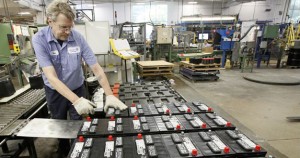Stop-Start Engines Stop Waste, Start Jobs
 The average American idles his or her engine about 16 minutes a day. That means we burn about 10.6 billion gallons of gas each year–nearly a month’s supply–to go absolutely nowhere. That gas is wasted.
The average American idles his or her engine about 16 minutes a day. That means we burn about 10.6 billion gallons of gas each year–nearly a month’s supply–to go absolutely nowhere. That gas is wasted.According to the automotive experts at Edmunds.com, “You can make a Corolla get the same gas mileage as an 18-wheeler by sitting in the car with the air-conditioner running while waiting in an elementary-school pickup line.”
Experts concur that if you’re waiting for more than 30 seconds, you’ll save gas by stopping and restarting your engine. You’ll keep the air cleaner, too. Some cities and states even have anti-idling laws to prevent air pollution. When I was at the New York Attorney General’s Office, we brought a series of anti-idling cases that resulted in mandatory driver training for most of the public school bus fleet, protecting kids from breathing in polluted air outside schools.
However, a recent survey from Vanderbilt University shows that many people are unaware that most engine idling is unnecessary, wasteful, or even dangerous. We have our own calculus as to when to cut the engine–depending on how hot or cold it is, how long the line is, or who we’re waiting for. What we don’t think about is how much gas we’re wasting.
An improved engine technology, already widespread in Europe, takes the guesswork out of when to stop idling–and will save drivers hundreds of dollars each year in gas costs. It’s also helping drive job growth in the Midwest, the heart of the automotive manufacturing industry.
Stop-start technology automatically shuts off your engine when your car is stopped, but leaves your radio, air conditioning, and other electronics running off the battery. When you release the brakes or engage the clutch, the engine seamlessly restarts. The technology can boost fuel efficiency by 5 to 10 percent.
This feature has actually been around since the 1980s, but improved batteries, such as absorbent glass mat, or AGM batteries, have made the system a lot smoother. Reviewers test driving the 2013 Ford Fusion say “you barely feel the transition” (Autoweek), and that the technology is “smoother than that of the 3 series BMW” (Road and Track).
Start-stop technology is already standard in some vehicles, or adds an incremental cost of about $300 as an option–a cost that’s recouped in less than 2 years, according to the American Automobile Association.
As automakers continue to improve fuel efficiency to meet the new federal mileage standards, more cars will be equipped with stop-start technology. Researchers predict 8 million cars will have it by 2017; the EPA estimates that one out of four cars will use stop-start technology by 2025.
Equipping more cars with stop-start technology does more than save gas and money–it also drives job growth. Battery maker Johnson Controls recently invested $138 million in its Holland, Ohio plant, to ramp up production of AGM batteries. The company, which employs 400 people, recently hired 50 new workers to meet its new North American production targets. They aim to sell 6 million a year.
Mike Placzkiewicz, an operator at Johnson Controls and member of UAW Local 12, says,”I see a good future as the AGM battery takes off with the new vehicles. It should work out for us, and keep more people employed here.”
You can return to the main Market News page, or press the Back button on your browser.

